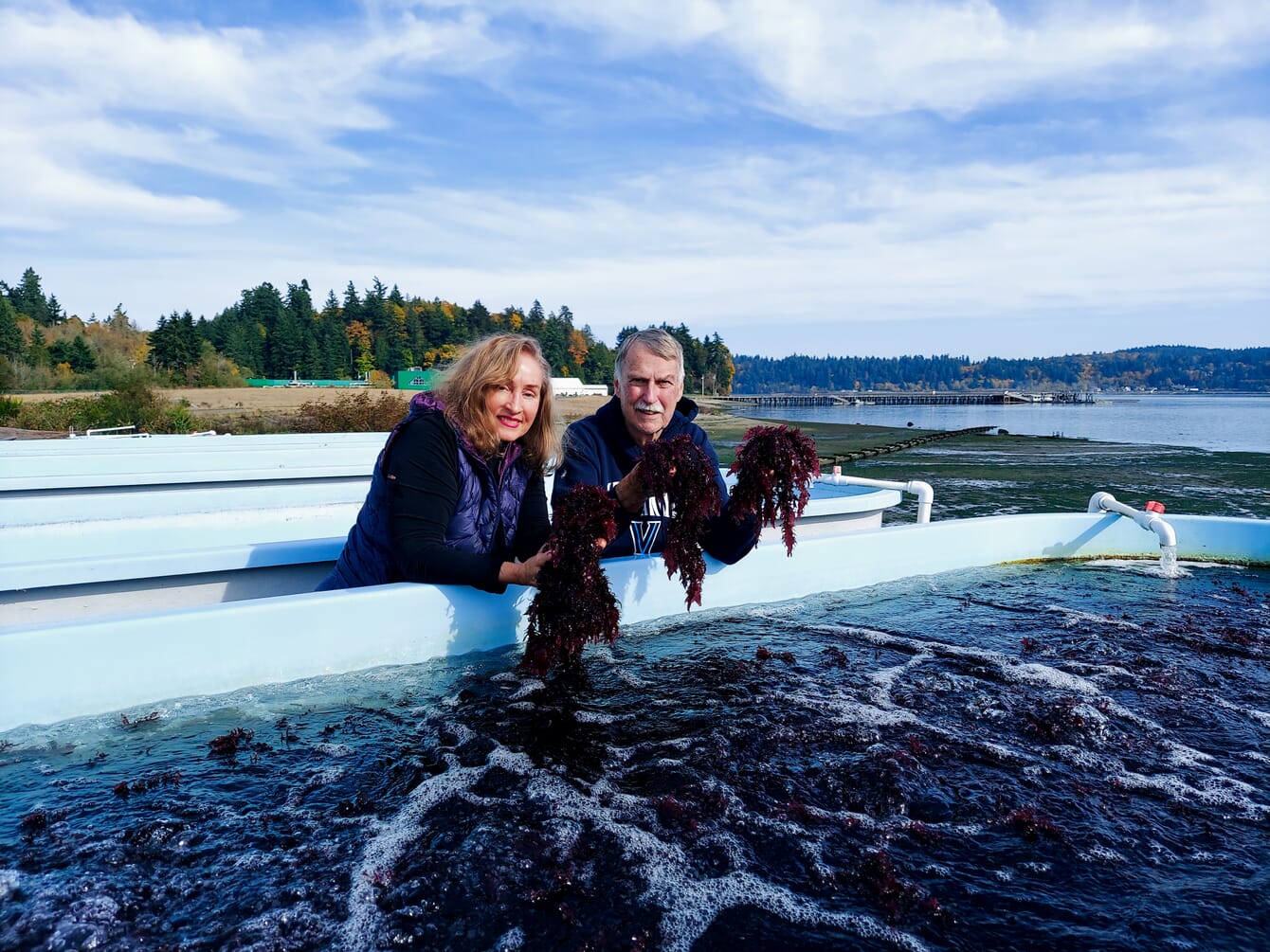
Diane Boratyn and Dr John Colt show off examples of seaweed produced in SOLSEA’s 1,200-gallon, land-based culturing tanks © SOLSEA Ltd
The power of partnership
When Diane Boratyn first decided to grow macroalgae on land to support her plant-based skincare company, she knew about the health benefits of seaweed, but lacked the know-how to cultivate it consistently on a commercial scale. She quickly learned that it would take large-scale production of seaweed to be competitive in expanded markets. Boratyn has a mind for business innovation and was fully aware that in order to be successful, she needed to grow more, better and faster.
Dr John Colt was a research fish biologist at the National Oceanic and Atmospheric Administration (NOAA)* Northwest Fisheries Science Center in Seattle, Washington. He is an expert on aquaculture and since 2000 he has explored growing macroalgae in land-based systems. While he was well-versed in the science of growing seaweed in controlled environments at the time, he had yet to experiment with growing it at a scale and consistency that was marketable.
That’s where a public-private partnership between Boratyn and NOAA came into play.
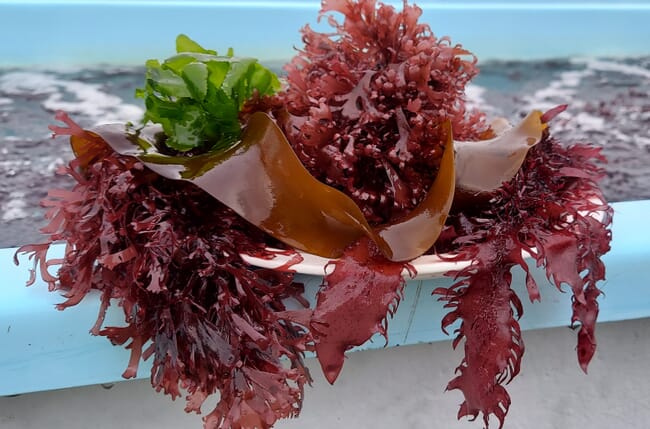
The public-private partnership between Boratyn and NOAA allowed both parties to access commercial grade seaweed year-round © SOLSEA Ltd
A catalyst for innovation
Having worked together in the past and realising their similar needs, Boratyn and Colt formalised their partnership with a CRADA, or Cooperative Research & Development Agreement, in 2015. A CRADA is one of the easiest and most flexible ways for small businesses to work with NOAA.
CRADAs are written agreements between a private US company, university or other entity and a NOAA laboratory or science centre. Both partners agree to work together on a collaborative research project and use their scientific results to develop commercially viable products and services.
When Boratyn and Colt started their research partnership, their main goals were to optimise the production of farm-raised seaweed and document how chemical compounds affected growth cycles. As a result of this collaboration, Boratyn’s seaweed tanks at her company, SOLSEA Ltd, now work to their full potential and deliver sustainable, high-quality plants that can meet the demands of today’s growing markets. At the same time, Colt’s scientific research has demonstrated that land-based seaweed farming offers a productive alternative to traditional harvesting and ocean farming.
The CRADA partnership has been a win-win for Boratyn and NOAA.
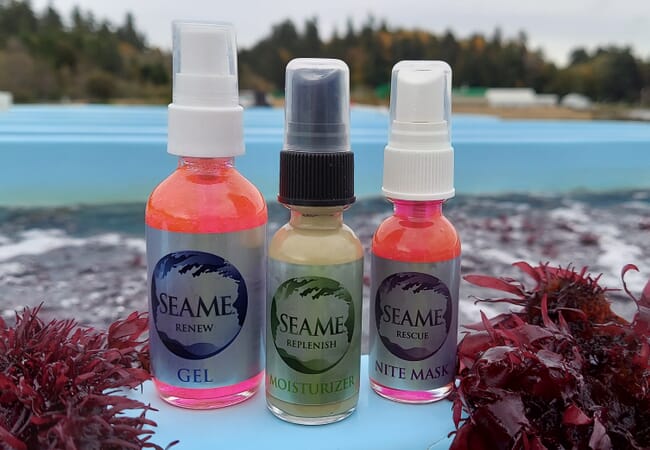
Boratyn creates skincare product lines that integrate vitamins, lipids, minerals and proteins originating from seaweed species that are indigenous to the Pacific Northwest © SOLSEA Ltd
The path to collaboration
Boratyn is a firm believer in the market potential of seaweed and seaweed products. Coming from an ocean and fisheries background, she began foraging for seaweed in the early 1990s to explore growth cycles and experiment with seaweed for cosmetic products. That activity turned into a skincare product line which integrated vitamins, lipids, minerals and proteins originating from a species of seaweed indigenous to the Pacific Northwest. Today, her company is focused on aquaculture technology and commercialising a wider diversity of products for food, fertilisers, animal feeds and plant-culturing operations.
Colt began working at NOAA in 1995 and has focused his research on aquaculture ever since. He argues that land-based seaweed farming offers a productive alternative to wild harvesting. This is especially true in the US, where open-ocean farming is restricted to a few areas and is subject to regulatory and permitting processes that limit its attractiveness to private companies.
Colt’s research and Boratyn’s market vision were meant for each other. Boratyn already had the cultivating tanks in place and Colt’s work at the Northwest Fisheries Science Center provided her with the analytical techniques to design the study. “We complemented each other on everything. It was a good mix,” reflected Colt.
Boratyn echoes his sentiment. “We found there was a mutually beneficial relationship,” she said. “We got to study seaweed growth rate, water quality and other scientific parameters while being able to develop high-end commercial products with a predictable and steady supply. It was beneficial all the way around.”
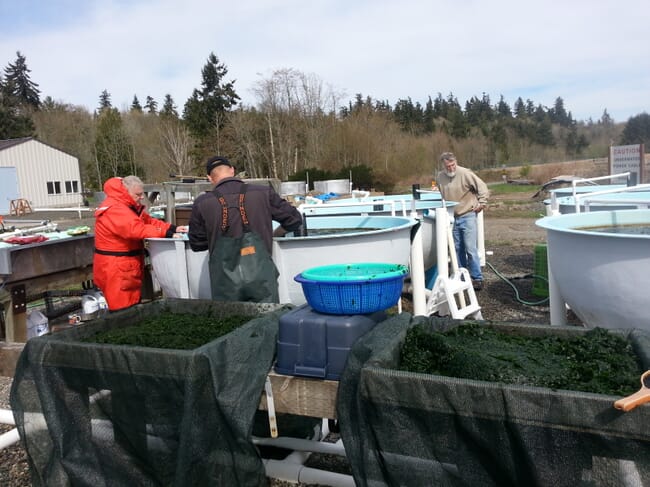
Researchers measure and weigh seaweed cultures during the building of new research databases © SOLSEA Ltd
A learning process
SOLSEA and NOAA’s partnership journey has involved tackling research problems – such as addressing various seasonal culturing challenges – that are key to mastering continuous growth cycles. Boratyn stated, “the last few years have been very challenging due to global warming and Covid-19. My goal in the next few years is to better understand how climate change impacts algae growth and to design better aquaculture systems to handle the inevitable changes that impact any farming system.”
Boratyn noted that another important aspect of the CRADA is the teamwork involved in learning how to navigate environmental impacts and other external influences. As the business changed over time, the researchers learned how to grow high-value species of seaweed, build new databases to log their findings and preserve native cultures of seaweed that became important for future genetic mapping and long-term stability of the business.
“The goal we had in mind was to grow our own seaweed, manufacture our products out of it and then put them in the market,” explained Boratyn. “As a business, we needed to clearly define our goal, our output and our final product. Most importantly, we realised that in order to build a good business model we needed reliable data from a good science base. That is why our collaboration with the Fisheries Science Center was fundamental," she explains.
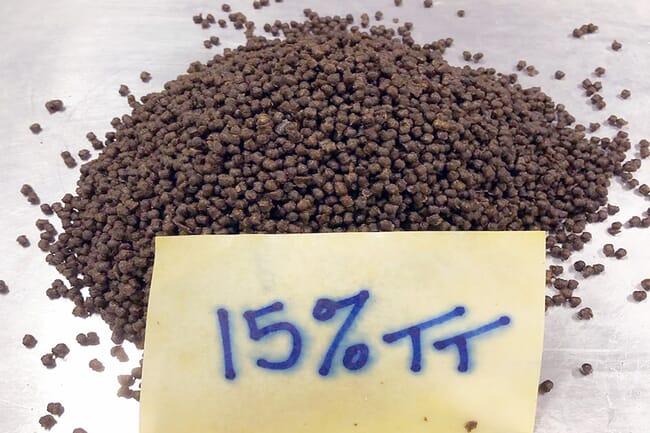
CRADA research has shown that the inclusion of red macroalgae known as Turkish Towel (indicated by the “TT” in this lab photo) in plant-based feeds for sablefish increases feed intake, fish growth and fish health © Ronald Johnson
The impact of a CRADA
The partnership between NOAA and SOLSEA has been economically successful and has substantially advanced scientific research.
SOLSEA has been able to expand its business from cosmetics to include fish food production and other potential revenue streams. Boratyn explained, “in the private sector, it is very important to not only have products on a weekly basis – which does not occur with a single annual harvest – but to come up with realistic economic models based on year-round production. This CRADA has allowed me to refine production and better forecast the company’s finances based on the species in new emerging markets.”
Colt noted that their CRADA provided fundamental proof of concept and helped the company get to the next level, while simultaneously allowing NOAA to conduct experimental research in large commercial systems. Colt added, “our research shows that it is possible to grow macroalgae with good yields over the entire year. We are also exploring the feasibility of putting two different types of macroalgae together where they can help each other grow while also keeping the tanks clean.”
Results of this partnership have highlighted the potential of US coastal communities to produce seaweed and have demonstrated that land-based systems are suitable for high-quality mass production. Through public presentations and publications, research findings from this CRADA have the potential to bolster the broader US aquaculture economy.
Looking back while looking forward
When asked to reflect on her CRADA experience, Boratyn stated: “From a company perspective – especially as a small business – it can be unaffordable to conduct the necessary foundational work and research. Our research partnership with NOAA helped us overcome the uncertainty of the question, ‘can we do this?’ and gave our business a leg up on expanded species production for new markets.”
Boratyn is already looking to the future, as she plans to develop the technology needed to expand land-based seaweed farming beyond her Seattle location and to integrate educational and community outreach elements into future sites of engagement.
Visit the NOAA Partnerships Page for additional information about the NOAA Technology Transfer Programme, view a list of NOAA’s active CRADAs and read about other CRADA success stories.
Note: Any reference obtained from this website to a specific company, product, process, or service does not constitute or imply an endorsement by NOAA.




